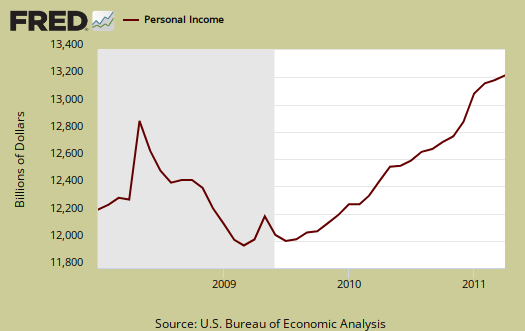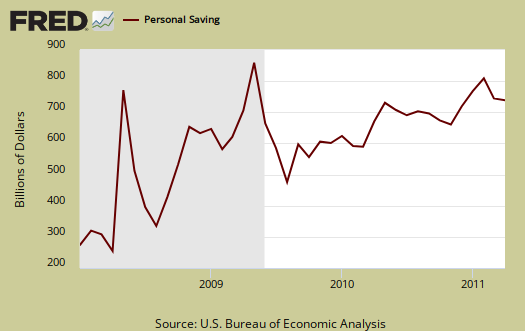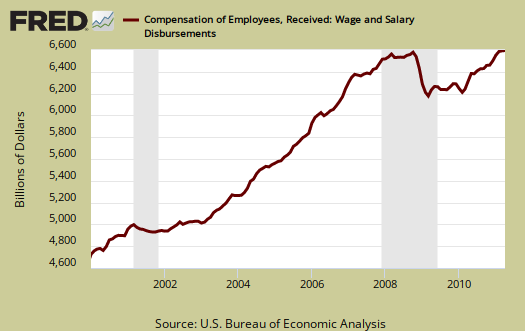The personal income & outlays BEA economic report for April 2011 is out. PCE or personal consumption expenditures increased 0.4%. Personal Consumption Expenditures are part of GDP, which had increased 2.2% for Q1. Take away inflation and PCE increased 0.1%. Real PCE, or personal consumption adjusted for inflation, is what is used to imply real GDP growth. Today's report has negative implications for Q2 2011 GDP.
Personal income increased 0.4% in April. Below is personal income, not adjusted for inflation, or price changes.

Disposable income is what is left over after taxes. DPI or disposable income increased 0.3% for April, but adjusted for inflation, was a big fat 0.0%. These numbers include income of the uber-rich.
Below is disposable personal income minus personal consumption expenditures monthly raw total changes.

Below is real disposable income per capita. Per capita means evenly distributed per person.

Pretty flat monthly change huh? The population in the U.S. increases approxminately 200,000 every month. What sounds really good initially, an increase in personal income, when spread across increased population growth, shows it's often not great news. The numbers reported in the press headlines are aggregates. Aggregate means everybody, the total.
Every worse, since real disposable income declined, this means inflation is hitting people in the pocket book now.
Personal consumption expenditures is the largest part of GDP, currently 70% of GDP is from PCE.
Below is a graph of real PCE, which is adjusted to not reflect inflation or price changes, in order to show the real economic activity versus the gouging at the checkout line and the pump.

The PCE price index increased 0.3%, but minus energy and food increased 0.2%. That's inflation. This implies real disposable income actually decreased, although less than 0.1%. For the year, energy alone has increased 19.6%.
Personal Savings was a 4.9% rate in April, same as March. Personal savings is disposable income minus outlays, or consumption.

On personal income, wages gave a monthly change of 0.4%. Below are wages and salaries for the past decade, on aggregate, not adjusted for inflation. Notice the dip and the more flat line than earlier in the decade. What's wrong with this picture?

Below is personal income minus transfer payments. This graph shows how much personal income increased that wasn't funded by the government. Transfer payments are payment from the government to individuals where no actual services (work) was performed. This includes social security, unemployment insurance, welfare, veterans benefits, Medicaid, Medicare and so on.
Here is what the above numbers do not show, the screw job on the poor, as shown by the spike up in the below graph. By real dollars, personal income minus transfer payments was 0% change for April. Notice real personal income minus transfer payments is below pre-recession levels.

To visualize more data from this report, consider playing around with more of the St. Louis Federal Reserve Fred graphs.

You are enough to notice
"Here is what the above numbers do not show, the screw job on the poor, as shown by the spike up in the below graph."
There's less relief during a recession for those who have lost their jobs. A marginal increase would be a difference for the poor and that would be an aid to the economy. But no, the Scrooge Principle prevails.
Our leaders should be ashamed of themselves but shame is a concept that doesn't meet their standards.
Michael Collins
Gap Between Personal Income and GDP
The difference between PI and GDP is composed of transfer payments, corporate profits largest and fastest growing piece. Transfer payments = SS + SSI + DI and others. What are all the pieces? The answer to this questions is how the poor are getting poorer, evident from the graph above compared to GDP. Overall
Personal Income is growing, that means the income of the rich.
Burton Leed
exactly, people think the government lies
and I can understand that, esp. from the BLS, but the truth is one can find the great income inequality, offshore outsourcing, labor arbitrage in these numbers. It's just a matter of knowing where to look.
Check out productivity and the decline in real compensation per hour. It's a horror show.